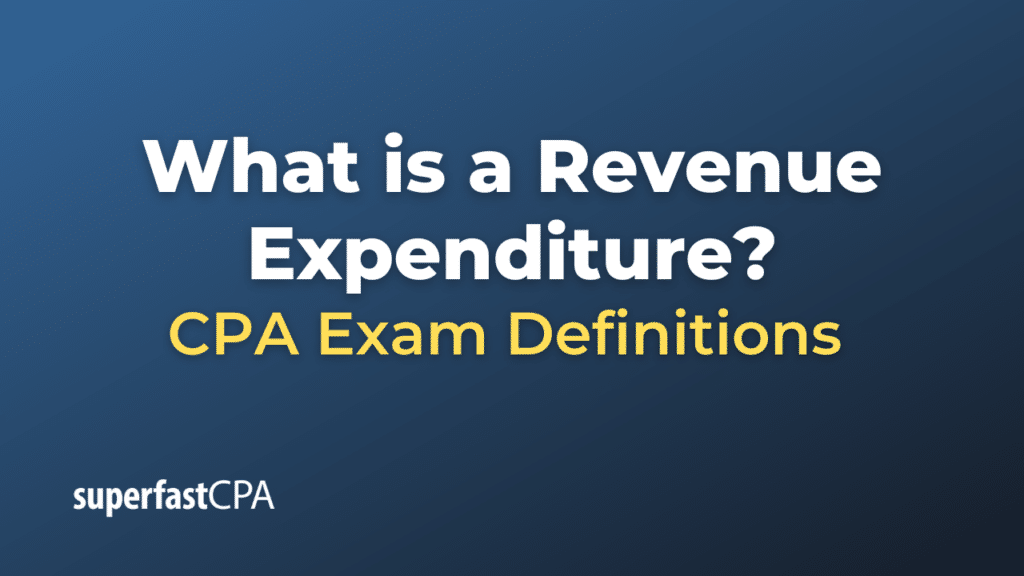Revenue Expenditure
A “Revenue Expenditure” refers to the expenditure which is incurred for the regular day-to-day conduct of business operations and is not meant to benefit the business over a prolonged period of time. Instead, it benefits the business immediately and its effect is consumed within the same accounting year. Revenue expenditures are considered as expenses and are matched against the revenue of the same accounting period to determine the profit or loss.
Here are some key characteristics and examples:
- Short-term Impact: The benefits of revenue expenditures are consumed within the current accounting period, typically within a year.
- Expense, Not Asset: Unlike capital expenditures which result in the acquisition of a long-term asset, revenue expenditures are treated as expenses that reduce the company’s income for the accounting period.
- Examples:
- Wages and Salaries: Payments made to employees for their regular work.
- Rent: Payments for using a property or equipment for business operations.
- Utilities: Payments for electricity, water, and other utilities used in the business.
- Routine Maintenance and Repairs: Costs incurred to keep assets in their normal working condition.
- Advertising and Promotion: Costs incurred to promote the business or its products/services.
- Accounting Treatment: Revenue expenditures are immediately charged against revenues in the income statement (profit and loss account), reducing the profit for the period. They do not add to the value of assets; instead, they are used up in the production of revenue.
- Contrast with Capital Expenditure : It’s important to differentiate revenue expenditure from capital expenditure. Capital expenditures are made for acquiring or improving long-term assets such as equipment, buildings, or land. The benefit of a capital expenditure is realized over several years. For example, the cost of a new machine for a factory is a capital expenditure, while the cost to maintain that machine is a revenue expenditure.
In essence, while revenue expenditures maintain the earning capacity of the business, capital expenditures increase the earning capacity. Proper classification between the two is crucial for financial reporting and analysis, as it impacts how expenses are recognized and how profits are calculated.
Example of a Revenue Expenditure
Bella runs a bakery in her hometown. She bakes bread, pastries, and cakes, and she’s renowned for her delicious blueberry muffins. In the month of April, Bella incurs various expenses to keep her bakery running smoothly.
April’s Expenditures:
- Ingredients Purchase: Bella spent $1,500 on flour, sugar, eggs, blueberries, and other baking ingredients.
- Electricity Bill: The ovens and lights consumed electricity worth $300.
- Rent: Bella’s bakery is located in a rented space costing $1,000 per month.
- Employee Salaries: Bella has two assistants for whom she pays a total of $2,500 in salaries for the month.
- Advertising: Bella spent $200 on a local newspaper ad promoting a new type of croissant.
- Maintenance: One of the ovens had a minor fault, and Bella spent $100 to get it repaired.
Revenue Expenditure Analysis:
All the above costs are revenue expenditures. Here’s why:
- Ingredients Purchase: These ingredients will be used up within the month to bake goods. They won’t provide benefits beyond April.
- Electricity Bill: This is a recurring monthly expense. Once paid, it doesn’t provide prolonged benefits.
- Rent: The rent provides Bella with a place to operate her bakery for that month only.
- Employee Salaries: Salaries are regular monthly payments for the work done by employees in that specific month.
- Advertising: The newspaper ad is a short-term promotion, and its benefits (increased sales due to advertisement) are likely to be realized within April.
- Maintenance: The oven repair ensures the oven continues working as before. It doesn’t enhance its functionality or extend its life significantly.
In April, Bella’s total revenue expenditure was $4,600 ($1,500 + $300 + $1,000 + $2,500 + $200 + $100).
Contrast with a Potential Capital Expenditure: Suppose Bella decided to expand her business and bought a new, advanced oven for $5,000. This oven is expected to last for 10 years. This expenditure would be a capital expenditure because the oven is a long-term asset that will benefit Bella’s bakery for many years. The cost of this oven would not be fully expensed in April; instead, its cost would be spread over its useful life, typically through depreciation.
By distinguishing between her regular, short-term expenses (revenue expenditures) and long-term investments (capital expenditures), Bella can better understand her bakery’s financial health and performance.












